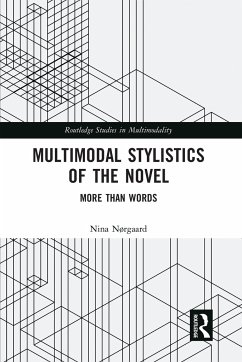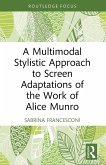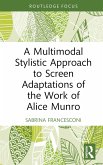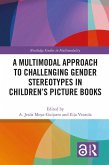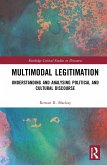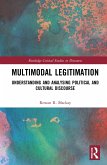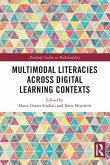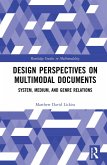- Broschiertes Buch
- Merkliste
- Auf die Merkliste
- Bewerten Bewerten
- Teilen
- Produkt teilen
- Produkterinnerung
- Produkterinnerung
This book advocates for a new analytical framework that extends our understanding of multimodal meaning-making in the novel.
Andere Kunden interessierten sich auch für
![A Multimodal Stylistic Approach to Screen Adaptations of the Work of Alice Munro A Multimodal Stylistic Approach to Screen Adaptations of the Work of Alice Munro]() Sabrina Francesconi (Italy University of Trento)A Multimodal Stylistic Approach to Screen Adaptations of the Work of Alice Munro30,99 €
Sabrina Francesconi (Italy University of Trento)A Multimodal Stylistic Approach to Screen Adaptations of the Work of Alice Munro30,99 €![A Multimodal Stylistic Approach to Screen Adaptations of the Work of Alice Munro A Multimodal Stylistic Approach to Screen Adaptations of the Work of Alice Munro]() Sabrina Francesconi (Italy University of Trento)A Multimodal Stylistic Approach to Screen Adaptations of the Work of Alice Munro69,99 €
Sabrina Francesconi (Italy University of Trento)A Multimodal Stylistic Approach to Screen Adaptations of the Work of Alice Munro69,99 €![A Multimodal Approach to Challenging Gender Stereotypes in Children's Picture Books A Multimodal Approach to Challenging Gender Stereotypes in Children's Picture Books]() A Multimodal Approach to Challenging Gender Stereotypes in Children's Picture Books42,99 €
A Multimodal Approach to Challenging Gender Stereotypes in Children's Picture Books42,99 €![Multimodal Legitimation Multimodal Legitimation]() Rowan R. MackayMultimodal Legitimation58,99 €
Rowan R. MackayMultimodal Legitimation58,99 €![Multimodal Legitimation Multimodal Legitimation]() Rowan R. MackayMultimodal Legitimation198,99 €
Rowan R. MackayMultimodal Legitimation198,99 €![Multimodal Literacies Across Digital Learning Contexts Multimodal Literacies Across Digital Learning Contexts]() Multimodal Literacies Across Digital Learning Contexts42,99 €
Multimodal Literacies Across Digital Learning Contexts42,99 €![Design Perspectives on Multimodal Documents Design Perspectives on Multimodal Documents]() Matthew David LickissDesign Perspectives on Multimodal Documents180,99 €
Matthew David LickissDesign Perspectives on Multimodal Documents180,99 €-
-
-
This book advocates for a new analytical framework that extends our understanding of multimodal meaning-making in the novel.
Produktdetails
- Produktdetails
- Routledge Studies in Multimodality
- Verlag: Taylor & Francis Ltd
- Seitenzahl: 368
- Erscheinungstermin: 30. Juni 2020
- Englisch
- Abmessung: 229mm x 152mm x 20mm
- Gewicht: 602g
- ISBN-13: 9780367584542
- ISBN-10: 0367584549
- Artikelnr.: 68758435
- Herstellerkennzeichnung
- Libri GmbH
- Europaallee 1
- 36244 Bad Hersfeld
- gpsr@libri.de
- Routledge Studies in Multimodality
- Verlag: Taylor & Francis Ltd
- Seitenzahl: 368
- Erscheinungstermin: 30. Juni 2020
- Englisch
- Abmessung: 229mm x 152mm x 20mm
- Gewicht: 602g
- ISBN-13: 9780367584542
- ISBN-10: 0367584549
- Artikelnr.: 68758435
- Herstellerkennzeichnung
- Libri GmbH
- Europaallee 1
- 36244 Bad Hersfeld
- gpsr@libri.de
Nina Nørgaard is Carlsberg Semper Ardens Research Fellow and Associate Professor of Applied Linguistics in the Department of Language and Communication at the University of Southern Denmark, where she is also director of Centre for Multimodal Communication. Nina is the author of numerous articles and book chapters on multimodal stylistics.
Figures. Permissions. Preface. 1 Introduction. 1.1 Aims and motivations.
1.2 Structure of the book. 2 Multimodal stylistics - what, why and how?
2.1 Preliminaries. 2.2 Stylistics. 2.2.1 Formalist stylistics. 2.2.2
Functionalist stylistics. 2.2.3 Historical stylistics. 2.2.4 Cognitive
stylistics. 2.2.5 The cornerstones of stylistics. 2.3 Social semiotic
multimodal theory. 2.3.1 Multimodality, modes and semiotic resources. 2.3.2
Discourse, design, production and distribution. 2.3.3 Further remarks on
social semiotic multimodal theory. 2.4 Multimodal stylistics. 2.4.1
Motivations and challenges. 2.4.2 Multimodal stylistics today. 2.4.3 Doubly
deictic subjectivity, mimesis and defamiliarisation. 2.4.4 Other approaches
to multimodality and the novel. 2.5 Further methodological considerations.
2.5.1 Literary data I: multimodality and the novel. 2.5.2 Analytical focus
- text, context, author, reader. 2.5.3 Literary data II: selection and
representation of examples. 2.6 Concluding remarks. 3 Wording. 3.1
Preliminaries. 3.2 Experiential meaning - language as representation. 3.2.1
Experiential meaning in The sound and the fury. 3.3 Interpersonal meaning -
Language as exchange. 3.3.1 Interpersonal meaning in The sound and the
fury. 3.4 Textual meaning - Language as text. 3.4.1 Textual meaning in The
sound and the fury. 3.5 Faulkner's text as a functional act of
communication between author and reader. 3.6 Concluding remarks. 4
Typography. 4.1 Preliminaries. 4.2 A social semiotic multimodal approach to
typography. 4.2.1 Typographic distinctive features. 4.2.2 Typographic
semiotic principles. 4.2.3 Metafunctions and typography. 4.3 Typographic
meaning in the novel. 4.3.1 Index. 4.3.2 Icon. 4.3.3 Discursive import.
4.3.4 Symbol. 5.1 Concluding remarks. 5 Layout. 5.1 Preliminaries. 5.2
Kress and van Leeuwen's systems for the analysis of layout. 5.2.1
Information structure. 5.2.2 Salience. 5.2.3 Connectivity: framing and
linking. 5.3 The meaning of layout in the novel. 5.3.1 Paragraphs,
sections, chapters and pages. 5.3.2 Other types of text block. 5.3.3 Letter
spacing, line spacing, blank space. 5.3.4 Linking. 5.4 Concluding remarks.
6 Photographs, drawings and other graphic elements. 6.1 Preliminaries. 6.2
Kress and van Leeuwen's visual grammar. 6.3 The meaning of photographs,
drawings and other graphic elements in the novel. 6.3.1 Photographs. 6.3.2
Drawings. 6.3.3 Other graphic elements. 6.4 Concluding remarks. 7 The book
cover. 7.1 Preliminaries. 7.2 Graphic book cover designs - The curious
incident of the dog in the night-time. 7.3 Photographic book cover designs
- On the road. 7.4 Film tie-ins and bestseller emulation - discursive
import and the significance of context. 7.5 Concluding remarks. 8 The
materiality of the novel. 8.1 Preliminaries. 8.2 The book as a
three-dimensional object. 8.3 The physical form of cover and binding. 8.4
The semiotics of paper. 8.5 Concluding remarks. 9 Conclusion. 9.1
Preliminaries. 9.2 Insights and contributions. 9.3 Further directions.
Appendix A: Colour images. Appendix B: The multimodal stylistics toolkit.
Index.
1.2 Structure of the book. 2 Multimodal stylistics - what, why and how?
2.1 Preliminaries. 2.2 Stylistics. 2.2.1 Formalist stylistics. 2.2.2
Functionalist stylistics. 2.2.3 Historical stylistics. 2.2.4 Cognitive
stylistics. 2.2.5 The cornerstones of stylistics. 2.3 Social semiotic
multimodal theory. 2.3.1 Multimodality, modes and semiotic resources. 2.3.2
Discourse, design, production and distribution. 2.3.3 Further remarks on
social semiotic multimodal theory. 2.4 Multimodal stylistics. 2.4.1
Motivations and challenges. 2.4.2 Multimodal stylistics today. 2.4.3 Doubly
deictic subjectivity, mimesis and defamiliarisation. 2.4.4 Other approaches
to multimodality and the novel. 2.5 Further methodological considerations.
2.5.1 Literary data I: multimodality and the novel. 2.5.2 Analytical focus
- text, context, author, reader. 2.5.3 Literary data II: selection and
representation of examples. 2.6 Concluding remarks. 3 Wording. 3.1
Preliminaries. 3.2 Experiential meaning - language as representation. 3.2.1
Experiential meaning in The sound and the fury. 3.3 Interpersonal meaning -
Language as exchange. 3.3.1 Interpersonal meaning in The sound and the
fury. 3.4 Textual meaning - Language as text. 3.4.1 Textual meaning in The
sound and the fury. 3.5 Faulkner's text as a functional act of
communication between author and reader. 3.6 Concluding remarks. 4
Typography. 4.1 Preliminaries. 4.2 A social semiotic multimodal approach to
typography. 4.2.1 Typographic distinctive features. 4.2.2 Typographic
semiotic principles. 4.2.3 Metafunctions and typography. 4.3 Typographic
meaning in the novel. 4.3.1 Index. 4.3.2 Icon. 4.3.3 Discursive import.
4.3.4 Symbol. 5.1 Concluding remarks. 5 Layout. 5.1 Preliminaries. 5.2
Kress and van Leeuwen's systems for the analysis of layout. 5.2.1
Information structure. 5.2.2 Salience. 5.2.3 Connectivity: framing and
linking. 5.3 The meaning of layout in the novel. 5.3.1 Paragraphs,
sections, chapters and pages. 5.3.2 Other types of text block. 5.3.3 Letter
spacing, line spacing, blank space. 5.3.4 Linking. 5.4 Concluding remarks.
6 Photographs, drawings and other graphic elements. 6.1 Preliminaries. 6.2
Kress and van Leeuwen's visual grammar. 6.3 The meaning of photographs,
drawings and other graphic elements in the novel. 6.3.1 Photographs. 6.3.2
Drawings. 6.3.3 Other graphic elements. 6.4 Concluding remarks. 7 The book
cover. 7.1 Preliminaries. 7.2 Graphic book cover designs - The curious
incident of the dog in the night-time. 7.3 Photographic book cover designs
- On the road. 7.4 Film tie-ins and bestseller emulation - discursive
import and the significance of context. 7.5 Concluding remarks. 8 The
materiality of the novel. 8.1 Preliminaries. 8.2 The book as a
three-dimensional object. 8.3 The physical form of cover and binding. 8.4
The semiotics of paper. 8.5 Concluding remarks. 9 Conclusion. 9.1
Preliminaries. 9.2 Insights and contributions. 9.3 Further directions.
Appendix A: Colour images. Appendix B: The multimodal stylistics toolkit.
Index.
Figures. Permissions. Preface. 1 Introduction. 1.1 Aims and motivations.
1.2 Structure of the book. 2 Multimodal stylistics - what, why and how?
2.1 Preliminaries. 2.2 Stylistics. 2.2.1 Formalist stylistics. 2.2.2
Functionalist stylistics. 2.2.3 Historical stylistics. 2.2.4 Cognitive
stylistics. 2.2.5 The cornerstones of stylistics. 2.3 Social semiotic
multimodal theory. 2.3.1 Multimodality, modes and semiotic resources. 2.3.2
Discourse, design, production and distribution. 2.3.3 Further remarks on
social semiotic multimodal theory. 2.4 Multimodal stylistics. 2.4.1
Motivations and challenges. 2.4.2 Multimodal stylistics today. 2.4.3 Doubly
deictic subjectivity, mimesis and defamiliarisation. 2.4.4 Other approaches
to multimodality and the novel. 2.5 Further methodological considerations.
2.5.1 Literary data I: multimodality and the novel. 2.5.2 Analytical focus
- text, context, author, reader. 2.5.3 Literary data II: selection and
representation of examples. 2.6 Concluding remarks. 3 Wording. 3.1
Preliminaries. 3.2 Experiential meaning - language as representation. 3.2.1
Experiential meaning in The sound and the fury. 3.3 Interpersonal meaning -
Language as exchange. 3.3.1 Interpersonal meaning in The sound and the
fury. 3.4 Textual meaning - Language as text. 3.4.1 Textual meaning in The
sound and the fury. 3.5 Faulkner's text as a functional act of
communication between author and reader. 3.6 Concluding remarks. 4
Typography. 4.1 Preliminaries. 4.2 A social semiotic multimodal approach to
typography. 4.2.1 Typographic distinctive features. 4.2.2 Typographic
semiotic principles. 4.2.3 Metafunctions and typography. 4.3 Typographic
meaning in the novel. 4.3.1 Index. 4.3.2 Icon. 4.3.3 Discursive import.
4.3.4 Symbol. 5.1 Concluding remarks. 5 Layout. 5.1 Preliminaries. 5.2
Kress and van Leeuwen's systems for the analysis of layout. 5.2.1
Information structure. 5.2.2 Salience. 5.2.3 Connectivity: framing and
linking. 5.3 The meaning of layout in the novel. 5.3.1 Paragraphs,
sections, chapters and pages. 5.3.2 Other types of text block. 5.3.3 Letter
spacing, line spacing, blank space. 5.3.4 Linking. 5.4 Concluding remarks.
6 Photographs, drawings and other graphic elements. 6.1 Preliminaries. 6.2
Kress and van Leeuwen's visual grammar. 6.3 The meaning of photographs,
drawings and other graphic elements in the novel. 6.3.1 Photographs. 6.3.2
Drawings. 6.3.3 Other graphic elements. 6.4 Concluding remarks. 7 The book
cover. 7.1 Preliminaries. 7.2 Graphic book cover designs - The curious
incident of the dog in the night-time. 7.3 Photographic book cover designs
- On the road. 7.4 Film tie-ins and bestseller emulation - discursive
import and the significance of context. 7.5 Concluding remarks. 8 The
materiality of the novel. 8.1 Preliminaries. 8.2 The book as a
three-dimensional object. 8.3 The physical form of cover and binding. 8.4
The semiotics of paper. 8.5 Concluding remarks. 9 Conclusion. 9.1
Preliminaries. 9.2 Insights and contributions. 9.3 Further directions.
Appendix A: Colour images. Appendix B: The multimodal stylistics toolkit.
Index.
1.2 Structure of the book. 2 Multimodal stylistics - what, why and how?
2.1 Preliminaries. 2.2 Stylistics. 2.2.1 Formalist stylistics. 2.2.2
Functionalist stylistics. 2.2.3 Historical stylistics. 2.2.4 Cognitive
stylistics. 2.2.5 The cornerstones of stylistics. 2.3 Social semiotic
multimodal theory. 2.3.1 Multimodality, modes and semiotic resources. 2.3.2
Discourse, design, production and distribution. 2.3.3 Further remarks on
social semiotic multimodal theory. 2.4 Multimodal stylistics. 2.4.1
Motivations and challenges. 2.4.2 Multimodal stylistics today. 2.4.3 Doubly
deictic subjectivity, mimesis and defamiliarisation. 2.4.4 Other approaches
to multimodality and the novel. 2.5 Further methodological considerations.
2.5.1 Literary data I: multimodality and the novel. 2.5.2 Analytical focus
- text, context, author, reader. 2.5.3 Literary data II: selection and
representation of examples. 2.6 Concluding remarks. 3 Wording. 3.1
Preliminaries. 3.2 Experiential meaning - language as representation. 3.2.1
Experiential meaning in The sound and the fury. 3.3 Interpersonal meaning -
Language as exchange. 3.3.1 Interpersonal meaning in The sound and the
fury. 3.4 Textual meaning - Language as text. 3.4.1 Textual meaning in The
sound and the fury. 3.5 Faulkner's text as a functional act of
communication between author and reader. 3.6 Concluding remarks. 4
Typography. 4.1 Preliminaries. 4.2 A social semiotic multimodal approach to
typography. 4.2.1 Typographic distinctive features. 4.2.2 Typographic
semiotic principles. 4.2.3 Metafunctions and typography. 4.3 Typographic
meaning in the novel. 4.3.1 Index. 4.3.2 Icon. 4.3.3 Discursive import.
4.3.4 Symbol. 5.1 Concluding remarks. 5 Layout. 5.1 Preliminaries. 5.2
Kress and van Leeuwen's systems for the analysis of layout. 5.2.1
Information structure. 5.2.2 Salience. 5.2.3 Connectivity: framing and
linking. 5.3 The meaning of layout in the novel. 5.3.1 Paragraphs,
sections, chapters and pages. 5.3.2 Other types of text block. 5.3.3 Letter
spacing, line spacing, blank space. 5.3.4 Linking. 5.4 Concluding remarks.
6 Photographs, drawings and other graphic elements. 6.1 Preliminaries. 6.2
Kress and van Leeuwen's visual grammar. 6.3 The meaning of photographs,
drawings and other graphic elements in the novel. 6.3.1 Photographs. 6.3.2
Drawings. 6.3.3 Other graphic elements. 6.4 Concluding remarks. 7 The book
cover. 7.1 Preliminaries. 7.2 Graphic book cover designs - The curious
incident of the dog in the night-time. 7.3 Photographic book cover designs
- On the road. 7.4 Film tie-ins and bestseller emulation - discursive
import and the significance of context. 7.5 Concluding remarks. 8 The
materiality of the novel. 8.1 Preliminaries. 8.2 The book as a
three-dimensional object. 8.3 The physical form of cover and binding. 8.4
The semiotics of paper. 8.5 Concluding remarks. 9 Conclusion. 9.1
Preliminaries. 9.2 Insights and contributions. 9.3 Further directions.
Appendix A: Colour images. Appendix B: The multimodal stylistics toolkit.
Index.

